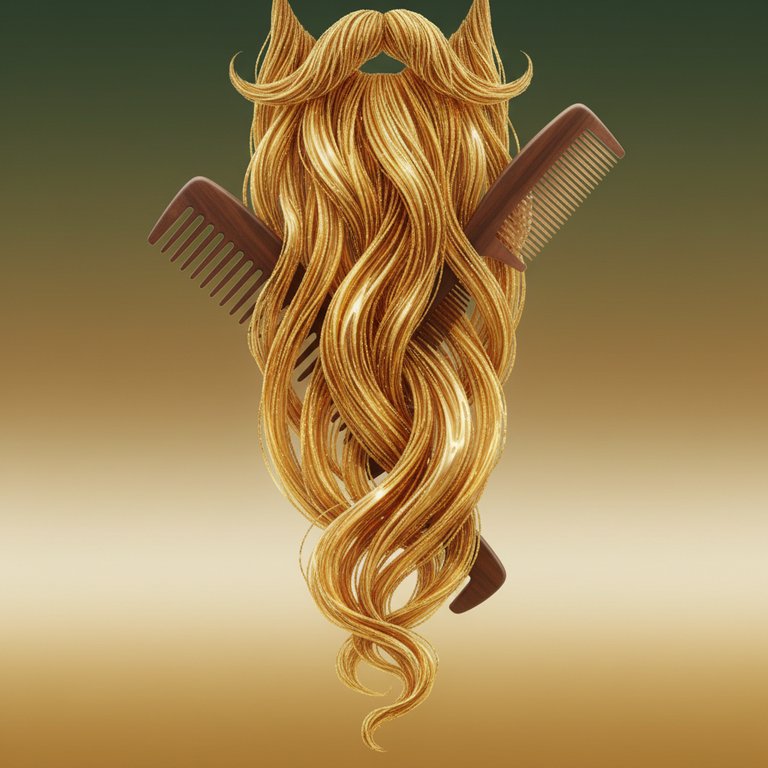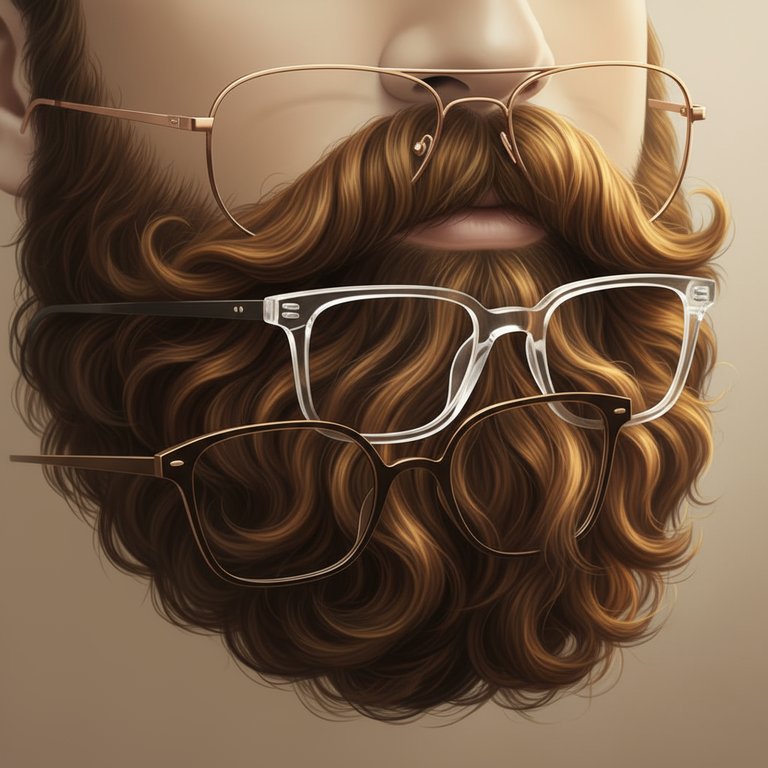Hey there, fellow beard enthusiasts! Let's be real for a moment. Growing a magnificent, flowing beard is a journey, and sometimes that journey comes with a few… hiccups. One of the biggest challenges for those of us rocking longer facial hair? You guessed it: tangles. That dreaded moment when your glorious mane decides to form a stubborn knot, turning your smooth cascade into a bird's nest. We've all been there, staring in the mirror, wondering if we'll ever get that comb through without a fight.
But fear not, my friend! You don't have to surrender to the snarls. Detangling a long beard isn't just about yanking through it; it's an art, a science, and a crucial part of keeping your beard healthy, handsome, and happy. In this comprehensive guide, we're going to dive deep into the best detangling combs and techniques that will help you conquer those knots and keep your long beard looking its absolute best. Get ready to transform your grooming routine!
Why Do Beards Get Tangled Anyway?
Before we jump into the solutions, let's briefly understand the enemy. Why do our glorious beards insist on tying themselves in knots?
- Hair Structure: Beard hair, especially as it gets longer, can be coarser and more prone to curling and interlocking than the hair on your head. This natural texture makes it a prime candidate for tangles.
- Friction: This is a big one! Think about it – your beard rubs against your clothes, your pillow, your scarf, your jacket zipper, and even your hands throughout the day. All that friction encourages individual hairs to twist around each other.
- Sleeping Position: Ever woken up with a "bed beard" that looks like it's been through a hurricane? Sleeping can be a major tangle creator as your beard gets squashed and rubbed against your pillowcase.
- Wind and Weather: A breezy day might feel nice, but it can wreak havoc on your beard, whipping hairs around and creating instant knots.
- Lack of Moisture: Dry beard hair is brittle and more likely to snag and break, leading to more tangles. Keeping it hydrated is key!
Understanding these causes helps us tackle the problem more effectively. Now, let's talk tools!
Your Arsenal: The Right Detangling Tools
Having the right tools is half the battle. Forget those tiny plastic combs that come with cheap grooming kits – your long beard deserves better!
Wide-Tooth Combs: Your First Line of Defense
When it comes to detangling, a good quality wide-tooth comb is your absolute best friend. But not just any wide-tooth comb!
- Material Matters:
- Wood (Sandalwood, Pearwood): These are fantastic. Wood is naturally anti-static, meaning it won't create frizz as you comb. They also glide smoothly through hair and distribute natural oils beautifully.
- Cellulose Acetate: This is a high-quality, plant-based plastic that's molded, not injection-molded. This means the teeth are seamlessly smooth, preventing snags and static that cheaper plastic combs often cause.
Avoid cheap plastic combs with visible seams or rough edges. These can actually damage your beard hair, causing breakage and split ends, making tangles worse in the long run.
- Tooth Spacing: The wider the teeth, the better for initial detangling. You want enough space for individual hairs to pass through without getting caught or pulled.
Boar Bristle Brushes: For Finishing Touches and Distribution
While a boar bristle brush isn't your primary detangling tool, it's essential for after the fact. Once your beard is knot-free, a good boar bristle brush will:
- Distribute Products: It helps spread your beard oil or balm evenly from root to tip.
- Smooth and Style: It tames flyaways, adds a healthy sheen, and helps shape your beard.
- Stimulate the Skin: The gentle bristles can stimulate the skin underneath, which is great for overall beard health.
The Power of Your Fingers
Never underestimate the power of your own digits! Your fingers are incredibly gentle and excellent for the initial loosening of larger knots. They allow you to feel out the tangles and work them apart without putting too much strain on individual hairs.
Prepping Your Beard for Detangling Success
You wouldn't try to untangle a dry, brittle rope, would you? The same goes for your beard! Proper preparation is crucial to minimize breakage and make the detangling process much smoother.
Beard Oil: The Lubricator
Think of beard oil as your beard's best friend, especially before detangling. A good beard oil provides a crucial layer of slip and lubrication, allowing your comb to glide through more easily.
- How to Apply: After a shower (or a quick rinse if your beard is dry), pat your beard until it's slightly damp, not soaking wet. Dispense a generous amount of beard oil into your palms (more for longer beards!). Rub your hands together to warm the oil, then thoroughly work it into your beard, ensuring it reaches the skin underneath and coats every strand from root to tip.
- Wait a Moment: Let the oil absorb for a minute or two. This gives it time to soften the hair and reduce friction.
Beard Balm/Conditioner: Extra Softness and Protection
For an extra boost of softness and manageability, especially if your beard is particularly coarse or prone to tangles, a good leave-in beard conditioner or balm can be a game-changer. These products often contain ingredients that further soften the hair and provide a protective barrier.
The Ultimate Step-by-Step Detangling Routine
Alright, you've got your tools, your beard is prepped – now let's get down to business. Patience is your greatest virtue here!
Step 1: Gentle Finger Detangling
This is where you start. Use your fingers to gently separate any large, obvious knots. Start from the very ends of your beard and slowly work your way upwards, teasing apart tangles with your fingertips. Don't pull or tug! If you encounter resistance, stop and try to gently wiggle your fingers through the knot.
Step 2: Introduce Your Wide-Tooth Comb
Once you've done the initial finger work, pick up your wide-tooth comb. Again, start at the very bottom (the ends) of your beard. Take small, short strokes, working on a small section at a time. As you comb, hold the section of beard hair above the knot firmly with your free hand. This prevents pulling on your skin and minimizes discomfort.
Step 3: Work Your Way Up
Gradually move your comb higher up your beard, section by section. Continue with short, gentle strokes, always starting below any new tangles you encounter. If you hit a snag, don't force it. Back out, reapply a bit more beard oil if needed, and gently try again from the bottom of that specific tangle. Repeat this process until your comb glides smoothly through your entire beard.
Step 4: Distribute and Style with a Boar Bristle Brush
Once your beard is completely detangled and smooth with the wide-tooth comb, it's time for the boar bristle brush. This step isn't about detangling anymore; it's about refining. Gently brush your beard from root to tip. This will help distribute any remaining beard oil or balm, smooth down the hair cuticles, and give your beard a neat, polished look. It also helps train your beard to grow in a more uniform direction.
Extra Tips for a Tangle-Free Life
Beyond the daily routine, here are a few more pro-tips to keep those tangles at bay:
- Don't Over-Wash: Washing your beard too often can strip it of its natural oils, making it drier and more prone to tangles. Aim for 2-3 times a week with a dedicated beard wash, and use conditioner every time.
- Pat Dry, Don't Rub: After washing, gently pat your beard dry with a towel instead of vigorously rubbing it. Rubbing creates friction and can lead to immediate tangles and frizz.
- Consider a Silk Pillowcase: Just like for head hair, a silk or satin pillowcase can significantly reduce friction on your beard while you sleep, preventing those notorious bed tangles.
- Braid or Tie Up for Activities: If you're going to be active, working out, or even just sleeping, consider loosely braiding your long beard or tying it up with a soft beard tie. This protects it from excessive movement and friction.
- Regular Trimming: Even if you're growing your beard long, regular micro-trims (every 4-6 weeks) can remove split ends and damaged hair, which are notorious for snagging and causing tangles.
- Patience is Your Best Friend: Seriously, detangling is not a race. Rushing will only lead to pain, breakage, and frustration. Take your time, enjoy the process, and treat your beard with the respect it deserves.
Your Burning Questions Answered: Detangling Edition
How often should I detangle my long beard?
Ideally, you should detangle your long beard at least once a day, preferably in the morning after you've applied your beard oil. If your beard is particularly prone to tangles due to activity or weather, a quick detangle in the evening before bed can also be beneficial. Consistency is key to preventing major knots from forming.
Why does my beard get tangled so easily even after using products?
Several factors could be at play! Your beard's natural texture (coarse, curly hair tangles more easily), exposure to wind or friction (from clothing, scarves, or even sleeping), or perhaps the products you're using aren't providing enough slip or moisture for your specific beard type. Ensure you're applying enough beard oil or balm and working it thoroughly through all the hair strands. Sometimes, trying a different product formulation can make a huge difference.
What happens if I just ignore the tangles in my long beard?
Ignoring tangles is a recipe for disaster! Small tangles will quickly grow into larger, more stubborn knots and eventually into matted sections. This can lead to significant hair breakage, split ends, and even patchy areas as hairs are pulled out or snap. It also makes your beard look unkempt, feels uncomfortable, and can be quite painful to eventually detangle. Trust me, it's worth the daily effort!
Can I use a regular hairbrush or comb on my long beard?
While you can, it's generally not recommended, especially for long beards. Regular hairbrushes often have bristles that are too stiff or closely spaced, and many plastic combs have rough seams that can snag, pull, and damage delicate beard hairs. This leads to breakage, split ends, and static. Stick to dedicated wide-tooth beard combs (preferably wood or cellulose acetate) and soft boar bristle brushes for the best results and beard health.
How long does it take to detangle a really matted beard?
Oh, the dreaded matted beard! The time it takes really depends on the severity. A light tangle might take a minute or two, but a truly matted beard could take anywhere from 15 minutes to an hour or even longer. It requires immense patience, generous application of beard oil or conditioner, and very gentle, methodical work. Don't rush it, and be prepared to take breaks if your hand gets tired or you get frustrated. It's a marathon, not a sprint!
Should I detangle my beard when it's wet or dry?
For long beards, it's generally best to detangle when your beard is slightly damp or dry. Wet hair is more fragile and elastic, making it more prone to breakage when stretched and pulled. If you detangle right out of the shower, gently pat your beard dry until it's just damp, then apply your beard oil or conditioner before beginning. Detangling a completely dry beard is also fine, as long as you've applied a good beard oil for lubrication.
Is there a specific way to hold the comb when detangling a long beard?
Yes, there is a technique! When you encounter a knot, use your free hand to firmly hold the section of beard hair above the tangle. This creates tension that keeps the pull from transferring to your skin and roots, making the process less painful and preventing hair from being yanked out. Then, use your comb with the other hand, starting from the very bottom of the knot and working your way down and out with short, gentle strokes.
Conclusion
Detangling a long beard might seem like a chore, but with the right tools, proper preparation, and a healthy dose of patience, it becomes an enjoyable and essential part of your grooming ritual. A well-detangled beard isn't just about looking good; it's about feeling comfortable, preventing damage, and ensuring your magnificent facial hair thrives.
So, embrace the process, invest in quality tools, and treat your beard like the regal mane it is. You'll be rewarded with a smooth, flowing, and truly glorious beard that turns heads for all the right reasons. Happy combing!
Disclaimer: The information provided in this blog post is for general informational purposes only and does not constitute professional advice. Always use grooming products and tools as directed by their manufacturers.



